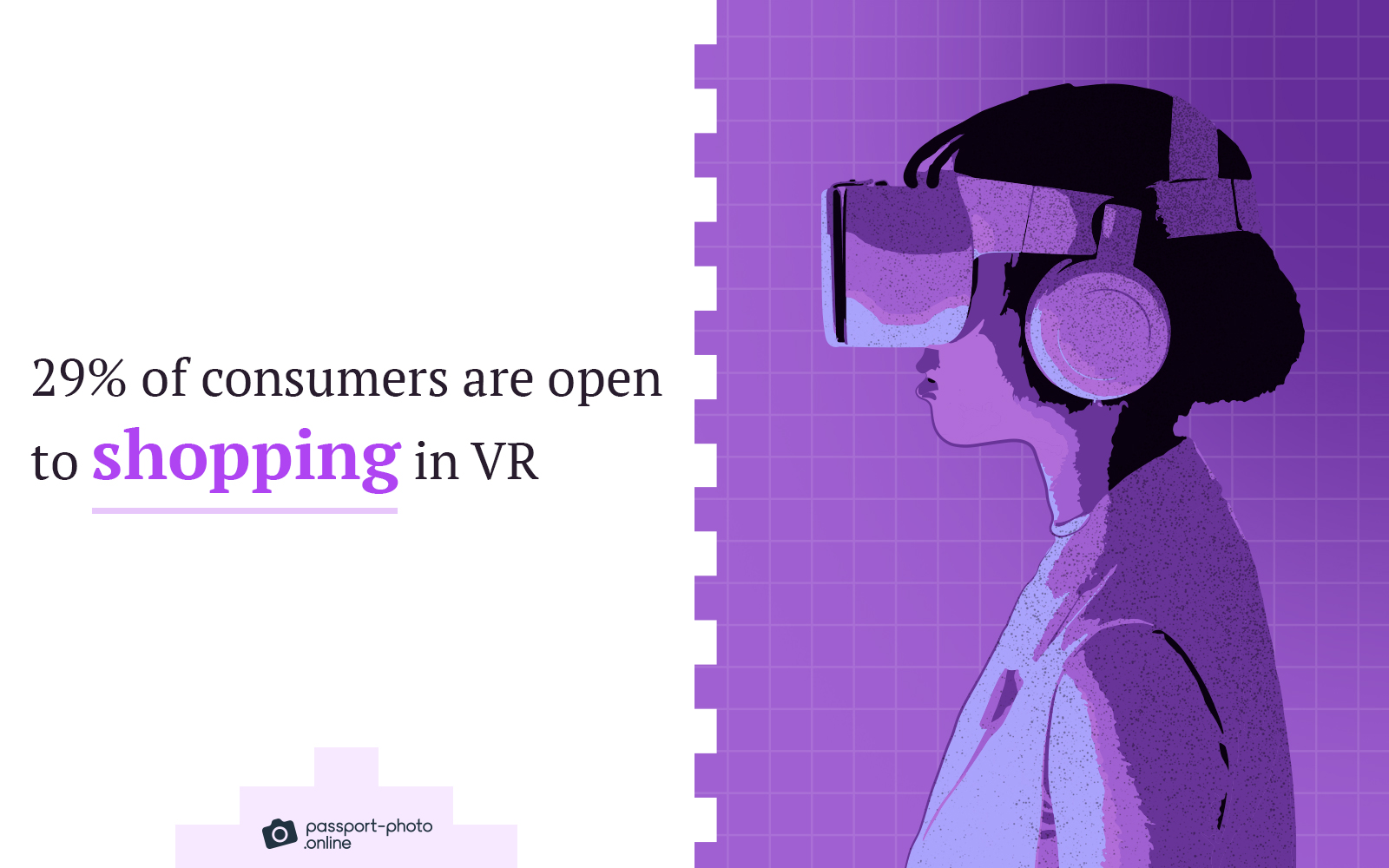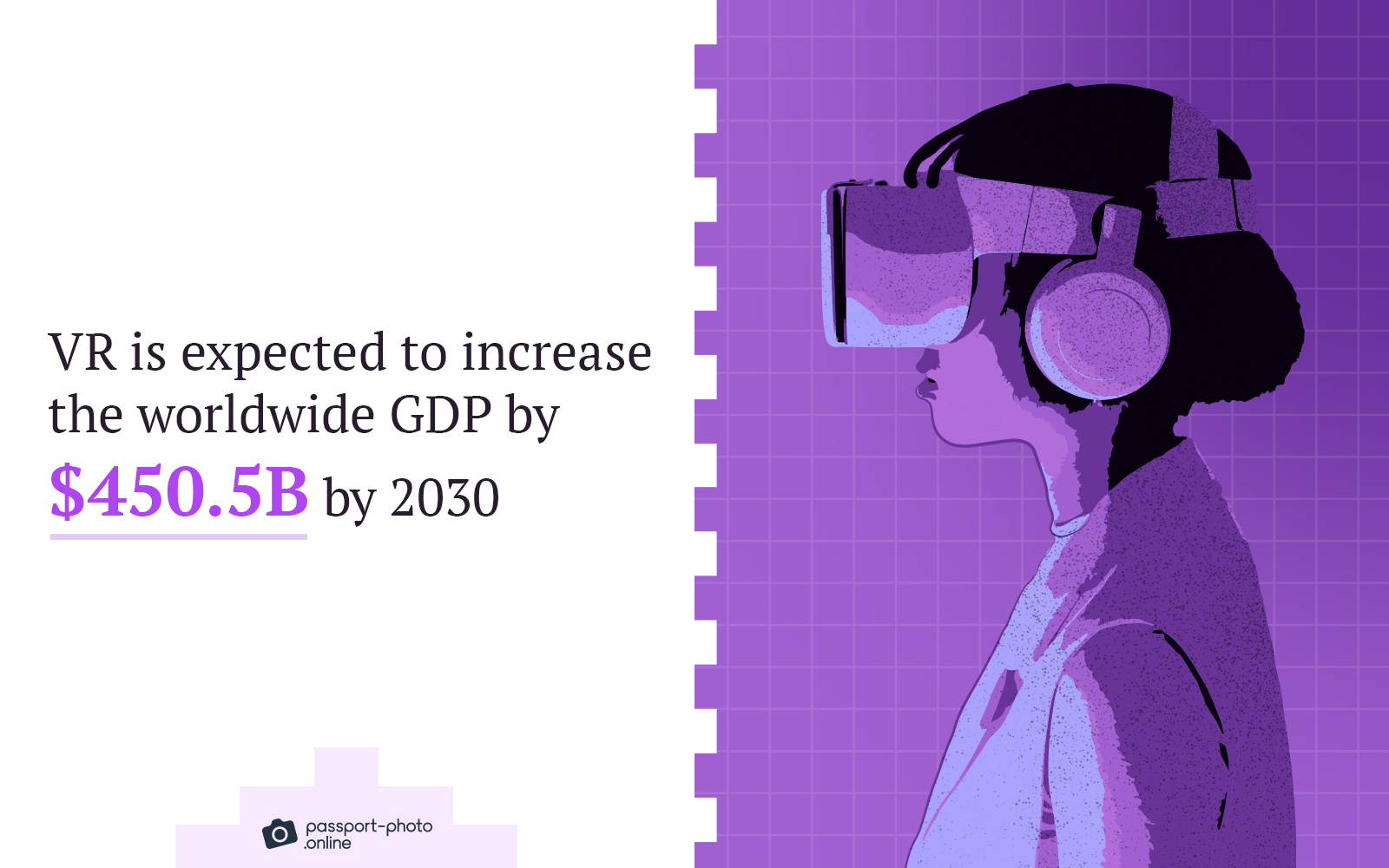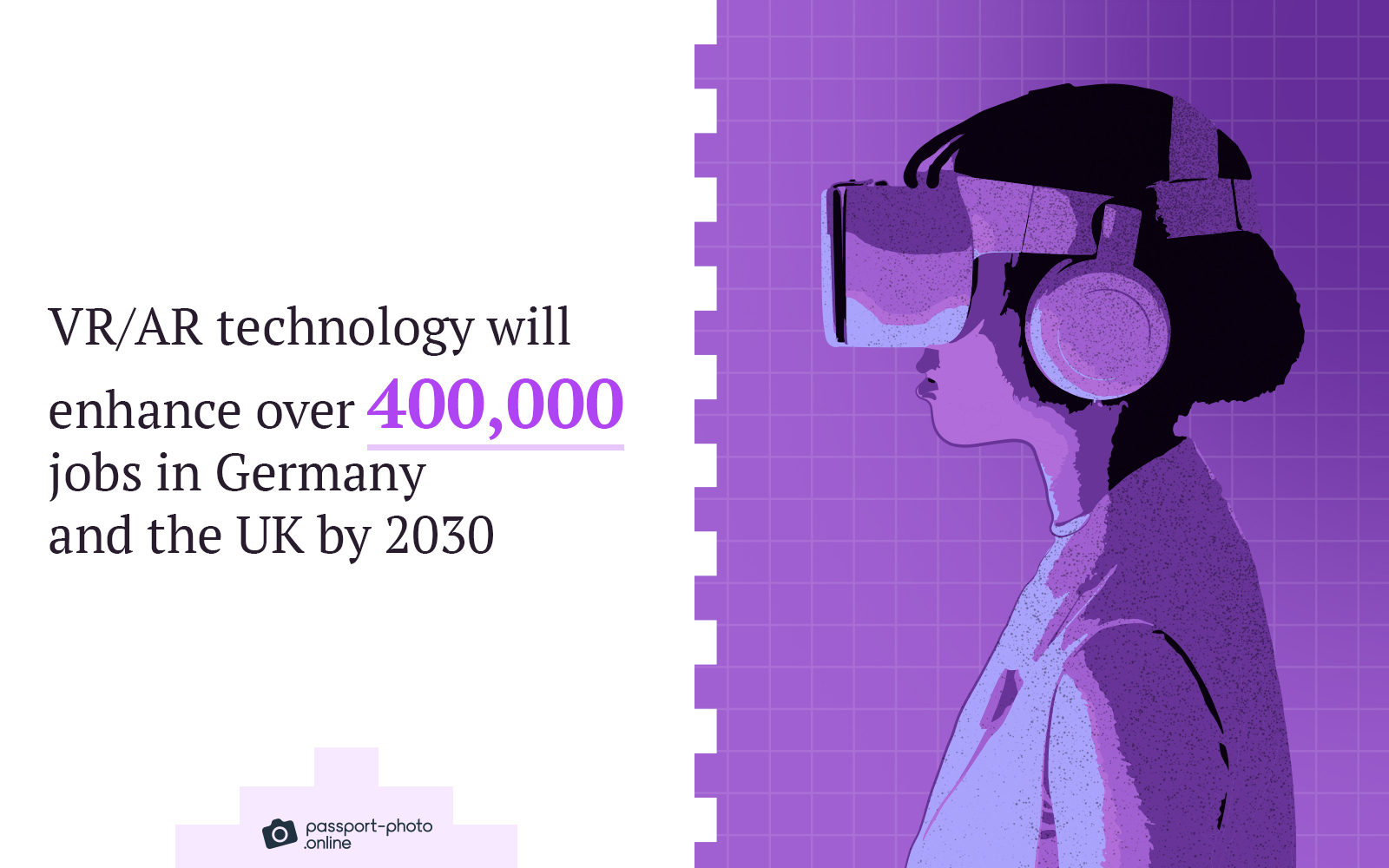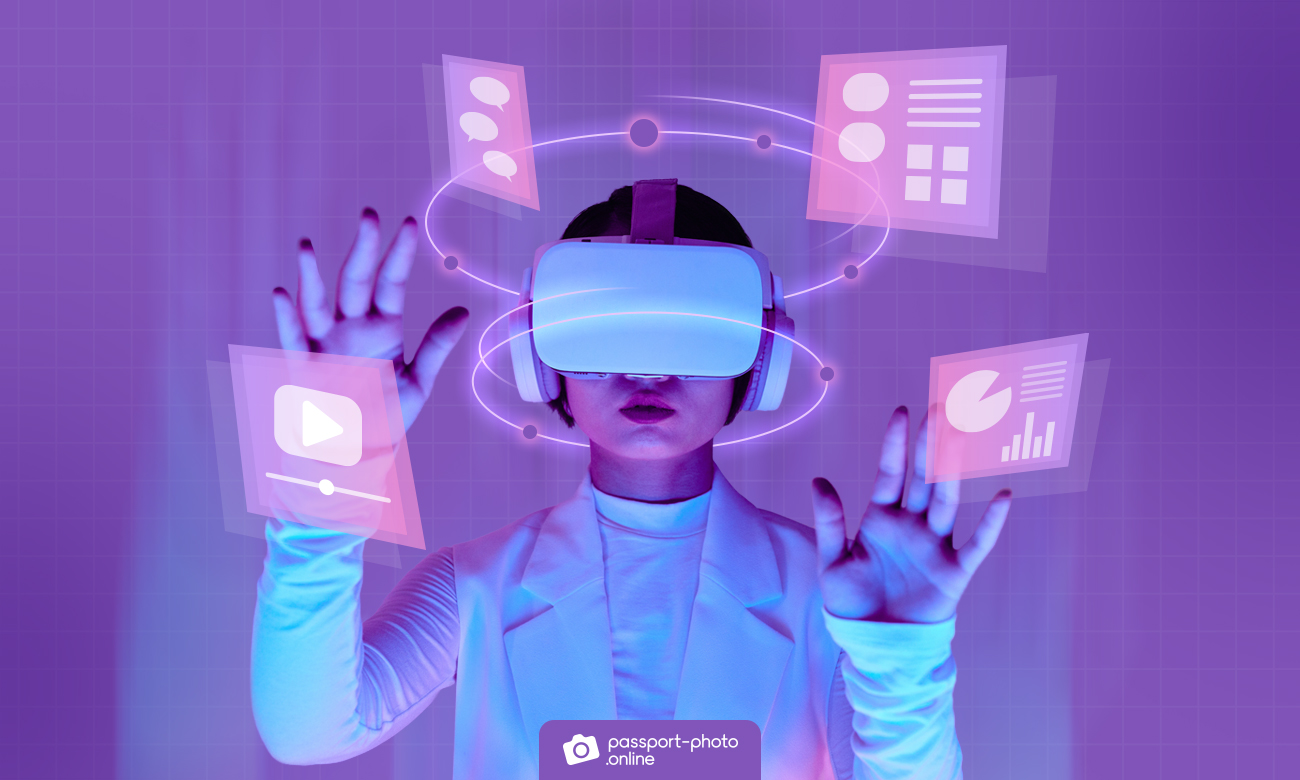Curious about the world of virtual reality in 2025?
Search no more.
We’ve gathered, vetted, and organized a list of the latest virtual reality stats for your convenience.
Top Virtual Reality Statistics (Editor’s Picks)
- The global virtual reality market is valued at $35B in 2023. It’s set to reach $87B, expanding at a compound annual growth rate (CAGR) of 13.8% through 2030.
- VR headset unit sales are expected to hit 11.2M worldwide in 2023 and rise to 14.31M in 2024.
- Over 171M people globally use virtual reality.
- The number of VR users in North America will reach 65.9M in 2023.
- Regardless of owning a VR headset, most US consumers hold favorable opinions of the technology: 37% are excited about VR experiences, while 43% show interest and willingness to use it under suitable conditions.
- The #1 reason for not buying VR devices is their high cost (46%).
- VR/AR technologies are forecast to enhance 23M+ global jobs by 2030.

- Almost 75% of Forbes’ World’s Most Valuable Brands use VR or AR.
- VR-trained employees learn up to 4x quicker than traditional classroom learners.
- VR adoption in e-commerce can improve online shopping conversions by 17%.
American Consumers vs. VR
- Four in 10 consumers are now more interested in VR due to COVID-19.
- Over half of consumers (57%) who’ve tried VR intend to have more virtual reality experiences in the future.
| Most Common Reasons to Get a VR Device | Share |
|---|---|
| I wanted to use it to play games | 53% |
| I wanted to see what all the hype was about | 33% |
| I generally like to keep up with new technology | 32% |
| A friend or family member recommended I get a VR device | 28% |
| It was a present for me or someone else in my household | 27% |
- About 32% of Millennials use AR technology, compared to 23% of Gen Zers, 14% of Gen Xers, and 6% of Baby Boomers.
- Nearly half of consumers (48%) have experienced VR at least once. Of those, 86% found their experiences to be “very” or “somewhat” positive.
| Where Have You Had a VR Experience? | Share |
|---|---|
| In my own home | 49% |
| In a friend or family member’s home | 43% |
| At a video game arcade | 33% |
| At a theme park | 21% |
| At a museum or art gallery | 12% |
- Close to 71% of VR headset owners generally describe themselves as early adopters of new technologies. They are usually white (61%), male (60%), aged 18–54 (94%), have children under 18 (58%), and play video games regularly (86%).
- About 13% of US households own a VR headset, with 68% having one, 23% having two, and 10% having three or more.
| Consumers’ Top Features When Choosing a VR Headset | Share |
|---|---|
| Good image resolution | 52% |
| Comfortable headset and controllers | 44% |
| High-quality audio | 39% |
| Easy and intuitive to set up | 35% |
| Compatible with a wide range of video games | 34% |
| Doesn’t require a connection to a PC or gaming console | 33% |
| Is compatible with my existing devices | 29% |
| Eye-tracking functionality | 28% |
- Among VR headset owners, 88% use it several times a month, while 60% use it more than once weekly.
- Roughly 54% of VR headset owners use it for under two hours weekly; 66% use it for 45 minutes, and 37% for less than 30 minutes at a time.
- Nearly 70% of VR headset owners use the device for gaming.
| How Have You Used Your VR Headset? | Share |
|---|---|
| Play video games or game-like VR experiences | 72% |
| Watch films or TV | 42% |
| Exercise or work out | 35% |
| Browse the internet | 29% |
| Create music, videos, or other art | 22% |
- Nearly half of consumers (42%) are unclear about the difference between VR and AR.
- Close to 37% of VR headset users experienced motion sickness during their last session, with 13% reporting severe symptoms.
- 42% of VR headset owners report that they or someone they know damaged an item at home while using the device.
| Consumers’ Most Common Complaints about Their VR Devices | Share |
|---|---|
| The headset gives me serious nausea or motion sickness | 17% |
| There isn’t a wide enough selection of games to play on it | 17% |
| The headset is uncomfortable | 16% |
| I miss being able to use my phone or other devices while I’m in the VR headset | 14% |
| There isn’t a wide enough selection of films or media to watch in VR | 14% |
- About 55% of consumers would be more inclined to buy a VR device if it had versatile uses like tablets or smartphones do.
- Two-thirds of consumers (66%) believe VR content must offer something beyond what traditional movies, TV, or games can provide to justify the investment.
- Almost half of consumers (47%) admit they’d be too frightened to try a virtual reality horror experience.
- Just 13% of people say they can use a VR headset for more than an hour without a break.
- Roughly three in ten consumers (29%) are open to shopping in VR.

- Around 20% of VR headset owners have used the device to attend live events.
- Almost six in 10 consumers (59%) would attend an event in person rather than through VR, even if they owned a headset and the ticket prices were the same.
- Work meetings in VR only appeal to one in five Americans, with 70% preferring apps like Zoom and Microsoft Teams for work communication.
- Almost four in 10 consumers (39%) are interested in using VR technology to visit a museum or art gallery.
- For nearly one-third of consumers (32%), doing exercise classes in VR is an appealing idea.
- About 31% of people are interested in using VR to socialize with friends and family.
- VR classes or educational events have piqued the interest of 26% of Americans.
- One in four people (24%) would consider using VR for a doctor’s appointment or medical checkup.
| What Worries You Most about the Social Impact of VR Technology? | Share |
|---|---|
| Children will spend too much time in VR | 40% |
| People will be less present in the real world | 39% |
| People will abuse, bully, or sexually harass others in VR | 33% |
| It’ll be harder for people to protect their privacy and personal information | 32% |
| Media will become more addictive than it’s today | 32% |
- About 31% of Americans would certainly attend a close friend or family member’s VR wedding if invited. In comparison, an additional 42% would likely attend.
- Nearly 56% believe most American households will have a VR headset by 2032.
- Almost 60% of people think VR and AR technologies will open up new opportunities for social advocacy.
- Roughly 61% of individuals think VR and AR can benefit children’s education.
- Nearly seven in 10 believe VR and AR technologies will open new avenues for artists and creators.
- Over two-thirds of people (69%) think VR and AR technologies will improve the lives of those with disabilities.
- AR and VR are seen as a way to experience other cultures and places by 70% of consumers.
- Half of parents are uncomfortable with their children using VR for more than three hours per week, and 8% don’t want their children to use it at all.
| Common Reasons Not Purchase a VR Device | Share |
|---|---|
| VR devices are too expensive | 46% |
| I don’t play enough games to justify getting one | 25% |
| I don’t see the appeal of VR experiences | 16% |
| I don’t know where to get started buying one | 15% |
| I’m worried about motion sickness | 12% |
| I’m waiting for VR devices to improve in quality | 12% |
| I’m worried about the impact it’ll have on my eyesight | 12% |
- Only one in five non-VR users are interested in trying the technology.
- Gen Zers (55%) and Millennials (60%) are the most familiar with the metaverse. Gen Xers (35%) and Boomers (17%) follow.
- Consumers’ most in-demand metaverse activities are playing games (23%) and socializing with friends (23%) in a virtual environment.
| Reasons for Engaging in Virtual Worlds Among Digital Fashion Consumers Worldwide | Share |
|---|---|
| I like to try out new technology | 89% |
| I think it’s fun/exciting | 76% |
| I want to immerse myself to escape | 50% |
| I want to be able to express myself | 47% |
| I want to feel like part of a community | 38% |
- A third of Gen Zers (33%) are interested in virtual stores where they can browse and purchase products.
- Close to 61% of young consumers are likelier to purchase from a brand that interacts with the virtual worlds they’re a part of.

Looking for passport photos? Discover more information:
General Virtual Reality Statistics, Facts, and Trends
- AR/VR global spending was estimated to reach $58.7B in 2022.
- There are 1,331 virtual reality startups in the US.
- Sony is the biggest player in the global market for Augmented and Virtual Reality, with a share of about 25%, followed by Oculus (Meta).
- In 2022, Oculus (Meta) was the top XR headset brand, capturing 66% of the market in the year’s second quarter. Pico ranked second with a market share of about 11%.
- VR is expected to significantly impact the global economy, with forecasts indicating it could increase the worldwide GDP by $450.5B by 2030.

- About 36% of game developers globally reported working on games for the Meta Quest VR headset in 2023.
- The most commonly recognized VR/AR technology product is the Oculus Quest (54%).
- Only 2% of Steam users own a VR headset as of August 2022.
- The Meta Quest 2 VR headset weighs 17.7 ounces (503 grams), making it significantly lighter than other VR headsets like the Valve Index, which weighs 28.5 ounces (809 grams).
- More than half of companies (51%) have already integrated or are currently integrating VR technology into their business strategies.
- VR-based training yields a 76% improvement in learning efficacy compared to conventional methods.
- The average price for a VR training program ranges from $40,000 to $155,000.
- The global volume in the VR headsets segment of the consumer electronics market is expected to grow by 5.5M units (+25.28%) between 2023 and 2028, resulting in 27.25M units sold in 2028.
- North America is expected to capture over 40% of the VR market by 2023, making it the largest share in the industry. It’s projected to continue to dominate the market, accounting for over 30% of the market value by 2030, with a forecasted growth rate of over 13%.
- VR revenue from consumers and enterprises reached $11.97B in 2022 and is forecasted to increase further to $15.81B in 2023.
- The global shipment of AR and VR devices reached 9.86M in 2021 and is expected to reach 18.81M units by 2023.
| Global Users’ Perspectives on the Advantages of Online or Virtual Entertainment Experiences (as of February 2022) | Share |
|---|---|
| Being able to stay home | 45% |
| Can experience things in faraway places | 41% |
| Less costly than “real life” experience | 40% |
| Allows us to experience things we wouldn’t be able to do otherwise | 40% |
| Safer | 35% |
| Can share experiences with friends/family who live far away | 32% |
- The global VR hardware B2C industry is projected to grow from $7.6B in 2022 to $15.09B by 2027.
- The combined market for AR, VR, and MR, collectively known as extended reality (XR), reached $41.22B in 2023 and is forecasted to exceed $100B by 2026.
| Xtended Reality (XR) Market Size Worldwide from 2021 to 2026 | In Billion US Dollars |
|---|---|
| 2022 | 29.26 |
| 2023 | 41.22 |
| 2024 | 54.58 |
| 2025 | 77.76 |
| 2026 | 100.77 |
- The global VR software B2C industry is expected to have revenue growth from $1.9B in 2022 to $5.45B in 2027.
- AR/VR headset shipments totaled 13.24M in the consumer market and 3.26M in the commercial market in 2022. The consumer market is expected to grow to 17.81M shipments in 2023.
- The global VR B2C industry is projected to see an increase in revenue to $20.72B by 2027.
- The estimated revenue for the global VR software B2C industry is set to reach $5.45B by 2027.
- The global VR hardware B2C industry is projected to see a significant revenue boost, reaching $15.09B by 2027.

- The VR advertising B2C industry is expected to generate a revenue of $177.3M by 2027.
- The global VR headset market revenue in the consumer electronics market is projected to increase by 25.05% from 2023 to 2028, reaching $2.3B.
- Between 2023 and 2028, the growth rate of the VR headsets segment in the consumer electronics market is expected to drop by ~12%.
- Between 2023 and 2028, the average revenue generated per user (ARPU) in the VR headsets segment of the consumer electronics market is expected to increase by $0.2, representing a growth rate of 16.67%. By 2028, the ARPU will likely hit $1.43.
- The global volume in the VR headsets segment of the consumer electronics market is expected to grow by 25.28% between 2023 and 2028, with a total increase of 5.5M units.
| Adults Worldwide Interested in Experiencing Different Types of Virtual or Online Activities (as of February 2022) | Share |
|---|---|
| Museum/art tour | 28% |
| Music concert | 28% |
| Classes for fun (e.g., dance, cooking) | 28% |
| Safari, zoo tour, etc., | 27% |
| Theatre/opera/dance performance | 26% |
| Travel | 26% |
| Fitness classes | 25% |
- VR gaming and video are set to dominate consumer use cases for VR technology, with spending estimated to reach $20.8B globally in 2023.
- The industrial use of VR technology is predicted to be 3x greater than consumer use worldwide by 2023.
| Worldwide Expenditure on Augmented and Virtual Reality Technology, Broken Down by Application in 2024 | In Billion US Dollars |
|---|---|
| VR gaming, VR video/feature viewing, and AR gaming | 17.6 |
| Training | 4.1 |
| Industrial maintenance | 4.1 |
| Retail showcasing | 2.7 |
- The VR market is expected to be dominated by North America by 2030, accounting for over 30% of the market value. The forecasted growth rate for the region is more than 13% from 2022 to 2030.
| Most Used VR and AR Technologies | Share |
|---|---|
| VR headsets (e.g., Oculus, HTC Vive) | 61% used; of those, 88% had a positive experience |
| Mobile VR apps | 33% used; of those, 66% had a positive experience |
| AR social media tools | 31% used; of those, 81% had a positive experience |
| VR motion controllers (e.g., standard hand controllers, wands, wheels) | 30% used; of those, 77% had a positive experience |
Virtual Reality in Europe: Statistics and Facts
- The European AR and VR market is expected to reach $8.02B in revenue by 2023, with an estimated CAGR of 14.13% between 2023 and 2027, resulting in a market volume of $13.61B by 2027.
- The AR and VR market in Europe is set to grow from $2.8B in 2021 to $20.9B in 2025.
- The AR and VR market revenue in Europe is projected to increase by $5.6B, reaching a new peak of $13.61B in 2027 after four consecutive years of growth.
- Over the next four years, the AR software segment of the AR and VR market in Europe is expected to grow by $1.2B (+42.25%), with revenue projected to reach $4.03B in 2027.
- VR/AR technology will enhance over 400,000 jobs in Germany and the UK by 2030.

- The European AR software B2C market is projected to see revenue growth to $3.8B by 2027. AR gaming remains the leading segment, estimated to reach $1.8B in the same year.
- The European AR hardware market is predicted to see a steady rise in revenue between 2023 and 2027, with an overall increase of $1.5B (+288.46%). It’s estimated that revenue will reach $2B in 2027, marking a new peak.
- The European AR advertising segment is projected to experience a 56.07% increase in revenue between 2023 and 2027, with estimated revenue reaching $1.85B in 2027 after four years of consecutive growth.
- VR technology is predicted to positively impact the economies of European countries such as Germany and the UK. Germany is projected to see a GDP boost of $29.8B by 2030, while the UK is forecast to gain $20.1B.
- VR devices are used by 10% of gamers in Poland.
- The European VR B2C market revenue is expected to rise to $5.03B by 2027, with VR hardware remaining the largest segment, accounting for $3.73B.
- The average cost of a VR headset in Europe was $430 in 2022 but is projected to decrease slightly in price in the coming years.
FAQ
How big is the virtual reality market?
What’s the growth rate of the virtual reality market?
How many people use VR?
How many VR headsets have been sold?
What percentage of Americans use VR?
How big is the virtual reality headset market?
Fair Use Statement
Did you like our infographics? If so, feel free to share them with your audience. Just remember to mention the source and link back to this page.
Sources
- ARtillery Intelligence, “VR Usage & Consumer Attitudes, Wave VII – ARtillery Intelligence”
- BIG THINK, “VR Training Is the Future. Here’s Why, and How Companies Are Using It”
- Forbes, “VR Headset Sales Underperform Expectations, What Does It Mean for the Metaverse in 2023?”
- GlobalData, “Virtual Reality (VR) Market: Global Industry Size and Forecasts by Product Type and Region 2021–2030”
- Grand View Research, “Virtual Reality Market Size, Share & Growth [2023 Report]”
- Harris Poll, “Americans Are Interested in AR, VR, and the Metaverse”
- MarketWatch, “Augmented and Virtual Reality (AR VR) Market Research, 2023-2030”
- National Research Group, “Beyond Reality: Is the Long-Awaited VR Revolution Finally on the Horizon?”
- PwC, “How Virtual Reality Is Redefining Soft Skills Training”
- Sourcing Journal, “Why Gen Z + Gaming = Fertile Ground for Fashion Retail Right Now”
- Statista, “AR & VR – Worldwide”
- Statista, “AR & VR – Europe”
- Statista, “Augmented Reality (AR) and Virtual Reality (VR) Headset Shipments Worldwide from 2019 to 2023”
- Statista, “Number of Virtual Reality (VR) and Augmented Reality (AR) Users in the United States from 2017 to 2023”
- Statista, “Virtual Reality (VR) Headset Unit Sales Worldwide from 2019 to 2024”
- Statista, “Virtual Reality (VR) – Statistics & Facts”
- Tracxn, “Virtual Reality Startups in United States”

As a Digital PR specialist and a member of the Society of Professional Journalists (SPJ), Max has 5+ years of writing experience.
Over the course of his career, Max’s work has garnered significant attention, with features in numerous prominent publications such as The New York Times, Forbes, Inc., Business Insider, Fast Company, Entrepreneur, BBC, TechRepublic, Glassdoor, and G2.









